The Center for Jewish History hosted a celebration of the 2013 75th birthday of the seminal superhero Superman on January 27th with co-sponsorship from Columbia University Library. Though Superman’s cover-date advent in comics occurred in June of 1938, celebrations are gearing up early to take a look back at the Kryptonian’s origins and the impact he’s made on comics and popular culture three quarters of a century later. While guests were hoping for an informative and lively event, most were surprised by just how gala the afternoon turned out to be, addressing two pertinent questions: What exactly lies behind the enduring appeal of Superman and how does that relate to his Jewish origins? Tickets, the price of which included a copy of Larry Tye’s biography of Superman (SUPERMAN: THE HIGH-FLYING HISTORY OF AMERICA’S MOST ENDURING HERO), sold out well ahead of time, however, overflow seating with live cast footage of the discussion panel were still available on the day of the event.
Press releases hinted that several big names would take to the stage to discuss Superman’s history and significance, and some of the stellar participants included author Larry Tye, Jenette Kahn (former president of DC Comics), Jim Shooter (who wrote many Superman comics before taking up a position as editor at Marvel Comics, and founded Valiant Comics among other companies), Nicky Wheeler-Nicholson Brown (author and granddaughter of Major Malcolm Wheeler-Nicholson, co-founder of the company that became DC Comics), Sam Norich (publisher of The Jewish Daily Forward), and David Weiss (son of an life-model for drawings of Superman). They were joined by Karen Green, Librarian for Ancient & Medieval History and Graphic Novels at Columbia University, who helped introduce the event, along with Judy Siegel, Director of Academic Programs at the Center for Jewish History. They addressed a diverse and enthusiastic crowd, eager to hear varying perspectives on Superman and take part in the discussion themselves.
Siegel gave the packed auditorium a little history behind the Center for Jewish History, and explained that due to their collection of over 100 million documents on Jewish cultural heritage, and given the Jewish origin of the “greatest superhero ever created”, the Center was clearly an excellent location for a celebration of Superman. Green also announced in her brief introduction that author Larry Tye’s voluminous research materials behind his “High-Flying History” of Superman would now be housed at Columbia University Library for the use of future scholars and researchers examining Superman’s place in the history of comics.
Tye, as Keynote speaker, related a number of personal anecdotes about working on and launching his Superman book, but also a general introduction to several key elements of Superman’s history and persona that relate to his Jewish roots in the minds of creators Jerry Siegel and Joe Shuster. Some of the things that surprised Tye during his research were learning that Superman had a long history of social activism, especially as a “homefront” hero during World War II, and finding out about Superman’s role in ridiculing and exposing the “real enemies” of America such as the Ku Klux Klan via radio broadcasts. The most recent insights into Superman’s origins and perhaps religious associations, however, have come in the form of documents unearthed during the lawsuits of the Siegel and Shuster heirs, Tye related.
The unpublished memoir of Jerry Siegel, specifically, holds many keys to the creation of the Superman character. In his memoir, Siegel tells stories of youthful bullying and a precocious turn to writing fiction, including writing a story about “The Super-Man”, a Super-Man who was more “super-bully” than savior. Siegel’s memoir also clarifies some of the details behind many of the circulating myths about his father’s untimely death. When Siegel was 17, his father, in fact, died of a heart attack while pursuing thieves from his haberdashery shop, not by gunshot wound as is often reported. It is true, however, that very shortly after his father’s death, Siegel “rewrote” the Super-Man story, entitling it simply “Superman”, and handing it off to his friend Joe Shuster. The first cover of the comics story depicted Superman saving a man from being robbed, a very personal note from Siegel’s own life.
[Jerry Siegel]
Tye addressed the subject of religious affinities and Superman, pointing our that “every faith on this planet has claimed Superman as theirs”, from Christianity to Buddhism, and even Atheists and Agnostics have hailed Superman as a “secular messiah”, but Tye stood by his assertion that Superman is essentially a Jewish hero rendered universal. From the “Moses and Exodus” journey that the infant Superman makes from Krypton, to the story of migration that his origin suggests, Siegel proves his statement “I write about what I know”. And what he, and Joe Shuster knew very well was growing up in a 70% Jewish neighborhood. But Superman’s universal qualities are perhaps the most mysterious thing to explain. Tye was fascinated by the “core” of Superman’s ethos, which he described as “a sense of righteousness, a sense of right and wrong” that is very attractive to readers.
[David Weiss]
Tye also introduced David Weiss to tell his own story about growing up as “the son of Superman”. Weiss’s father Stanley was approached as a young man by Joe Shuster at Green Mansions, a Jewish singles resort in the Adirondacks, and asked if he would sit for some sketches. Shuster informed Stanley Weiss that though he had never based his drawings of Superman upon any life models, drawing only from his “mind’s eye”, Stanley was the closest match for Superman Shuster had ever seen. Stanley Weiss sat for several sketches, and was given some to keep, which became part of the Weiss family’s personal mythology. David Weiss’s stories offered a new view of the past in Superman’s development, really reminding the audience of the human elements involved in all comics creating. Weiss, lastly, shared with the audience a display comparing a copy of one of Shuster’s portraits of Stanley Weiss alongside a photo of Weiss and a comics panel depicting Superman drawn by Shuster shortly after meeting Weiss. The resemblance was striking and helped illustrate the transition from life to comics page. David Weiss has also kindly shared the sketches of his father drawn by Shuster for display at the Center for Jewish History for a one-week exclusive exhibit.
[Superman sketch by Shuster of Stanley Weiss]
When the event opened up into its panel discussion and its participants were introduced, several other members of the comics industry and experts were also acknowledged in the audience, including Paul Levitz (former editor at DC Comics), grandchildren of Mort Weisinger, and Harry Donenfeld, and also Danny Fingeroth (former Marvel Editor, educator, and author of SUPERMAN ON THE COUCH and DISGUISED AS CLARK KENT). Celebrating Superman attracted both pros and fans alike. Samuel Norich opened by pointing out the importance of Superman in understanding the Jewish American experience while Jenette Kahn, herself the daughter of a Rabbi, described Superman essentially as “super mensch” from his odyssey in a Moses-like arrival on Earth to his “sense of responsibility” toward humankind. We “identify with Clark but we aspire to be Superman”, she commented.
Jim Shooter described Superman succinctly as “the greatest hero in the world”, to a round of applause and reminded the audience that he was personally responsible for a number of “crossovers” between Superman and Spider-Man during his days at Marvel, holding up a large format issue as evidence. Shooter reminisced that Julie Schwartz taught him to keep in mind the essential fact that Superman was simply “good”, a “good man” whose core and spirit would continue to appeal to readers. Kahn jumped in to agree with Shooter, adding that Superman is a being who “absolute power could absolutely not corrupt”, setting him apart from other heroes. Those essential premises, Shooter and Kahn feel are the reasons why Superman is “here 75 years later”. Norich added some of the Jewish American context for Superman, appearing in the 1930’s at a time when Jewish Americans were essentially in the “crosshairs” of many anti-Semitic media agencies and many felt there was simply nothing they could do to oppose the hate they encountered. They “needed something that could stand up, at least in their youthful imaginations”, Norich explained. But typical of the time was also the fact that Superman, like many immigrant families, could not “identify” publicly as being Jewish.
Nicky Wheeler-Nicholson Brown, like David Weiss, grew up with a “powerful family mythology” that focused on Superman, since her grandfather, “the Major”, was the first publisher to read a Superman story and suggest that it be published in 1933, though Superman would not hit the press until 1938. Interviewing relatives for her own forthcoming book about her grandfather, Wheeler-Nicholson Brown learned that the “appeal” of Superman to her grandfather was the sense that Superman was “really important” to pop culture in a very special way.
During the question and answer period, Kahn pointed out that Superman “never puts on a mask” and “always shows his face to us”, which creates an immediate connection with readers and sets him apart among early comic book heroes. If he has a “mask”, its simply the glasses of Clark Kent. Norich, conversely, felt that Superman “disguises himself as Jewish stereotype” in the persona of Clark Kent, when “we all know that’s not what he is”, creating an interesting “double layer” of meaning for the American Jewish identity. Norich explored the reasons behind Superman’s non-identification as Jewish, reminding that in the 1930’s, even Orthodox Jewish Americans did not wear public signs of their identity whereas in modern society, it’s acceptable to identify as both an ethnic group and an American, perhaps even popular to do so. Jim Shooter chimed in to relate the “coaching” he received writing Superman (writing which began at age 13!). They “wanted us to deliberately go out of our way not to exclude anyone”, he said, making Superman as universal a hero as possible. Both Shooter and Kahn provided stories of their experiences recognizing Superman’s global appeal as a “larger than life hero” whose comics have been translated into nearly every conceivable language. Shooter and Kahn also agreed that the maxim “no job too small, no job too big” has also contributed to the enduring appeal of Superman since if he performed no small, helpful tasks for individuals, he would lack the “common touch” and be less “grounded”, engendering less affection from fans.
During the Q&A session, the panelists were also asked to weigh in on the upcoming Superman film set for June 2013 release. Paul Levitz joined the discussion to say that he has a lot of confidence in director Zack Snyder, but has always maintained that Superman has the “ability to outlive our bad days, too”. “I’m very hopeful”, Levitz said, “this summer will be one of his very good days”. Shooter told the story of enlisting the entire Marvel office to go and see the first Superman film during his tenure, and then being confronted by a disappointed Stan Lee who, rather than thinking the outing inappropriate, was crestfallen that he, too, hadn’t been invited. Superman truly has universal appeal. That’s not to say that any discussion of Superman is complete without at least some elements of controversy over his publication history. The Donenfeld, Weisinger, and Wheeler-Nicholson grandchildren squared off politely from their respective corners of the auditorium during the Q&A on the subject of pay for Siegel and Shuster and the definition of “prevailing rate” of pay for these creators at the time of their work, however all shared fond personal memories of the role of Superman in their lives.
The depth of knowledge and experience brought to the event by its speakers and panelists made for a unique and informative event, but the sense of enthusiasm and personal connection to the subject matter from speakers and audience members alike really suggested a shared cultural experience that brings people together. Let’s not forget that there was birthday cake involved, another shared enthusiasm. The Center kindly presented three birthday cakes and refreshments in its packed atrium in commemoration of Superman’s 75th. The event was a substantial tribute to kick off the year of Superman, and explored many of the threads of tradition that have contributed to the rise of the Man of Steel in popular culture, as well as drawing well-deserved attention to the rich Jewish heritage behind Superman’s inception and ethos.
Hannah Means-Shannon writes and blogs about comics for TRIP CITY and Sequart.org and is currently working on books about Neil Gaiman and Alan Moore for Sequart. She is @hannahmenzies on Twitter and hannahmenziesblog on WordPress.




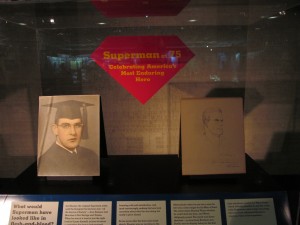
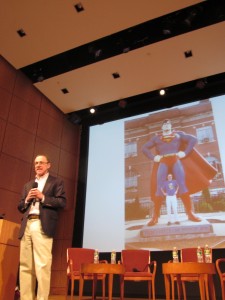

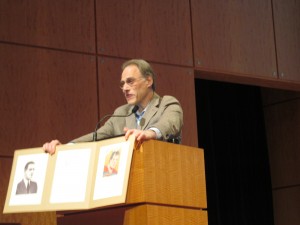
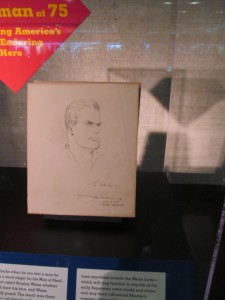
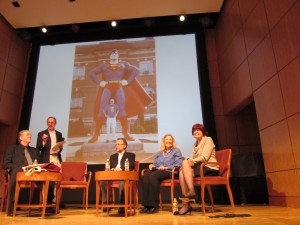
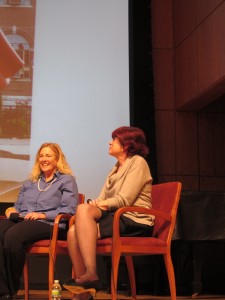
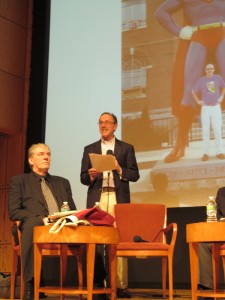
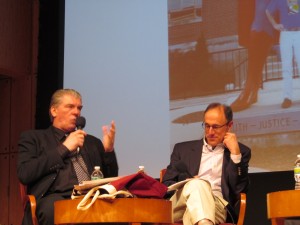
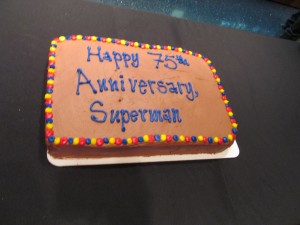
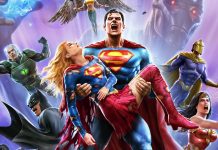
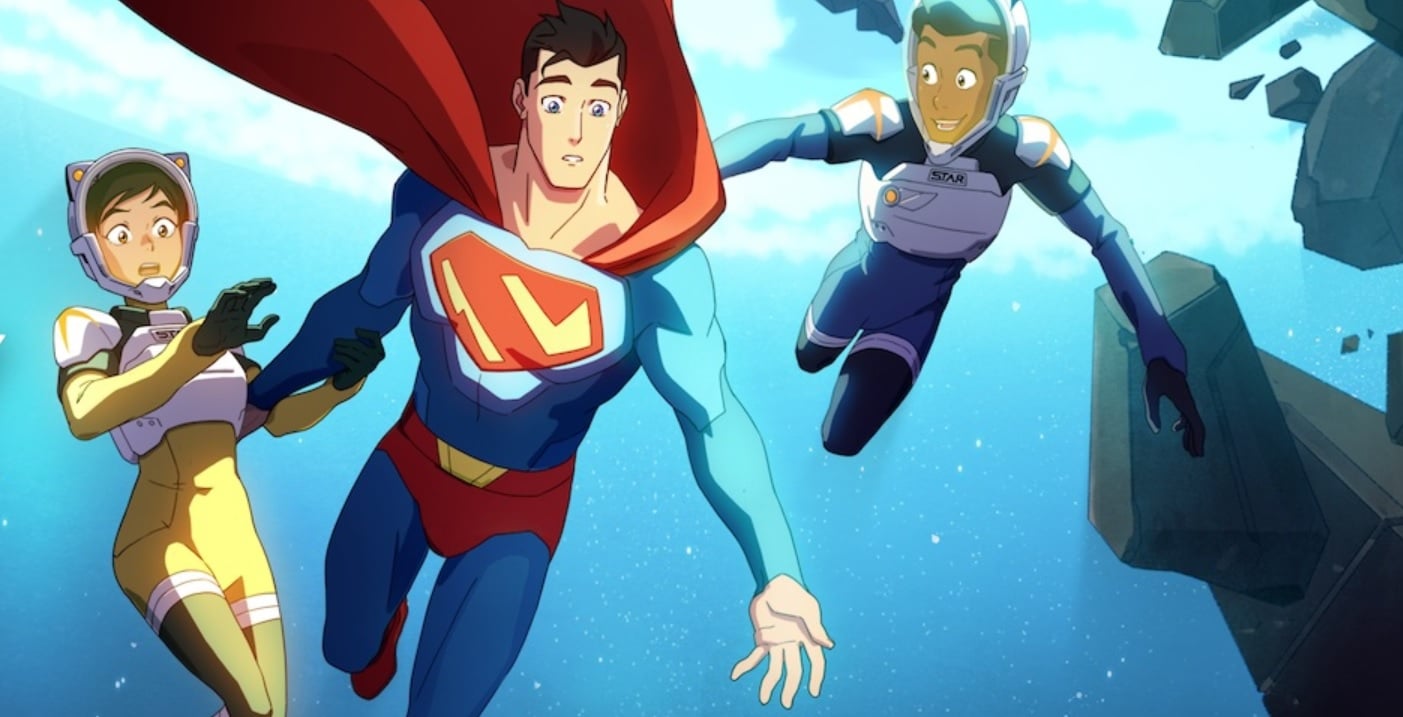
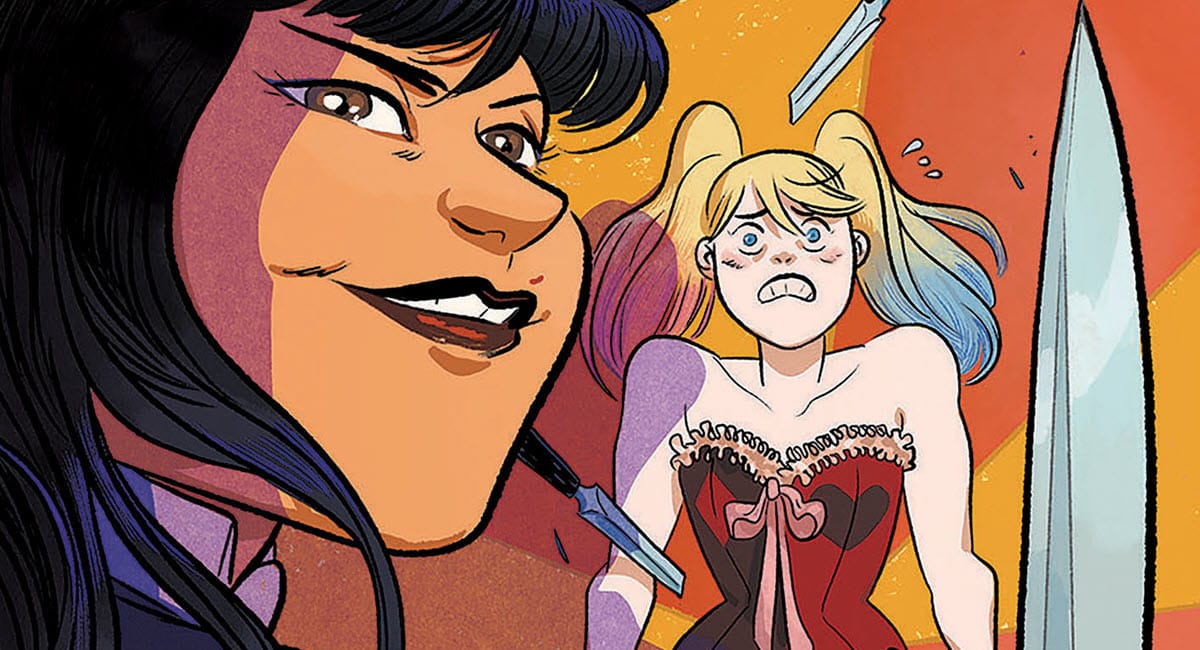






Happy Birthday Supes! I hope you have many more to come!
One correction to an otherwise accurate and thorough accounting of the event: In the paragraph about me, the “new archival document” was my creation, made possible by Karen Green arranging for us to get into the DC Comics vault to look through some of the old issues. I could never figure out why Superman in the issues I saw never looked like the sketch of my father. I now understand that Joe Shuster didn’t draw a majority of the issues. I recently researched which were the first issues credited to have been drawn by Shuster after he met my father. After confirming that Shuster’s drawings of Superman changed to look like the sketch of my father, starting in issue 39 of Superman (March April 1946), I bought a copy and created the side by side by side presentation of a photo of my father just two years before meeting Shuster, one of the sketches drawn by Shuster and one illustration from the first issue credited to have been drawn by Shuster after meeting my father – all with the same 3/4 profile. This is the first comparison that establishes the influence meeting my father had on Shuster’s drawings. I assembled this just a day before the event, so the only way to share it at the event was to bring it and show it.
Thanks David! I’ll correct that.
I grew up with david and I Knew his father. Spent many hours at his house and can tell you it was starnge knowing your friends father looked like Superman. Later on my wife meet David,s father when we needed to buy appliances in the store that Davids father worked . She always thought he was a good looking guy. It was great to see the pictures after all these years
Comments are closed.